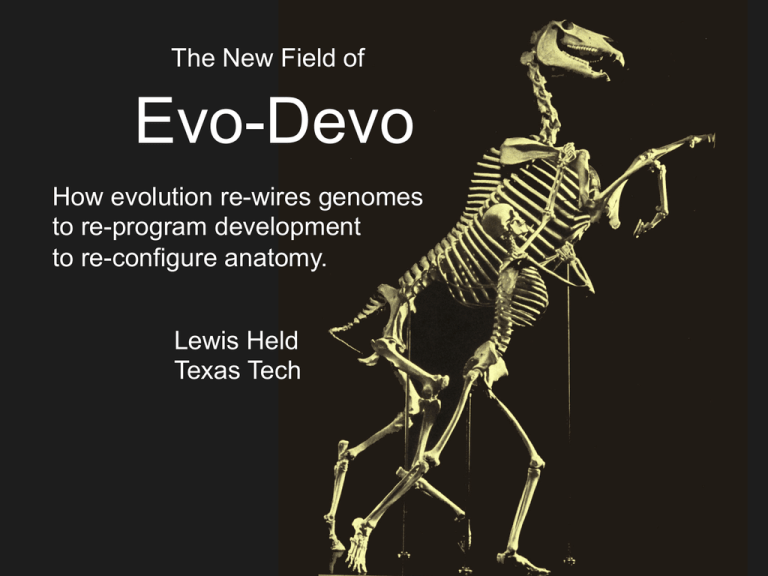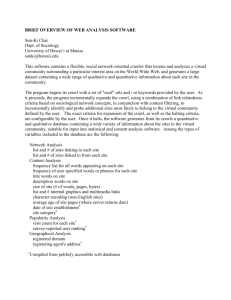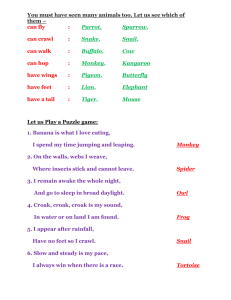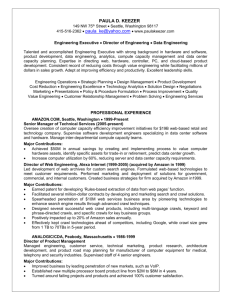Evo-Devo
advertisement

The New Field of Evo-Devo How evolution re-wires genomes to re-program development to re-configure anatomy. Lewis Held Texas Tech Outline Anatomy ≈ Geometry Cellular Programming Constraints on Evolution Human Evolution Why are we so naked? How did we get so brainy? Developmental Genetic Anatomy = Coding of cells in the body Geometry = Coding of points in space Example: Circle Code? Code = Cartesian Coordinates? Plot all (x,y), where x2 + y2 = r2. ≈ Wolpert Gradients x Morphgen x Morphgen y y Hmmm … Cartesian? Really? Try Polar Coordinates! r θ Code = Polar Coordinates? Plot all (r, θ), where r < 1. r 1 … but cells can be active (not just passive)! Cell Commands: Square Crawl forward 100 units. Turn right 90 degrees. Repeat 4 times. Cell Commands: Square Hexagon Crawl forward 100 units. Turn right 90 degrees. Repeat 4 times. Crawl forward 60 units. Turn right 60 degrees. Repeat 6 times. Cell Commands: Square Hexagon Crawl forward 100 units. Turn right 90 degrees. Repeat 4 times. Crawl forward 60 units. Turn right 60 degrees. Repeat 6 times. (4, 100) (6, 60) Polygon (n, s) Crawl forward s units. Turn right 360/n degrees. Repeat n times. (100, 1) Cell Commands: Dev. Program Square Hexagon Crawl forward 100 units. Turn right 90 degrees. Repeat 4 times. Crawl forward 60 units. Turn right 60 degrees. Repeat 6 times. (4, 100) Input Variables Polygon (n, s) Crawl forward s units. Turn right 360/n degrees. Repeat n times. (6, 60) Output Shapes (100, 1) Homology = Similarity due to Descent … with modification Dev. Program Cell Commands: 1:2:many:5 Input Variables Limb (n, s) Bone Joint sizes angles 1 Humerus Radius/ulna Carpals 2 Metacarpals many 5 Phalanges Turtle Human Horse Bird Bat Output Anatomies Seal Q: How does evolution rewire the genome? A: By changing the inputs to a conserved program, which changes anatomy. Why are some traits conserved … while others change very easily? Natural Selection Selective Pressure Misconception Organism Evolution Morphospace Natural Selection Selective Pressure Developmental Constraints Organism Evolution Morphospace “Geep” Ontogeny Recapitulates Phylogeny Gill slits (like a fish) Tail (like a monkey) Eyes on side (≈ fish) The number of neck vertebrae Is conserved in mammals.? Q: Why? A: Diaphragm! 1 2 7 6 5 4 3 16 23 Birds 7.. ... 1 Genetic Constraints 600 Million Yrs. Old! (Circuit Module) Co-option: Re-wiring of an old circuit (Hox) for a new function (fingers). Morphogen (Shh or BMP) = a (diffusible) signaling molecule. Gradient = assigning cell positions by morphogen concentrations. different anatomies different identities identical Individuation: Giving different identities to similar structures (via genes). Dissociation: The independent evolution of ≥ 1 members of a series. Individuation (in development) allows dissociation (in evolution). Homeosis: Changing one body part (thumb) to resemble another (finger). Mutations in Hoxd13 cause a “bear claw” phenotype! ≈ Q: How does evolution rewire the genome? A: By co-opting old circuits for new functions. Human Evolution Q: How does evolution rewire the genome? A: By tweaking cis-regulatory elements for area codes. Q: How does evolution rewire the genome? A: By changing the timing of gene expression (= Heterochrony). The history of evolution is written in our genomes! Summary How does evolution re-wire the genome to re-program development to re-configure anatomy? By changing the inputs to a conserved program. By co-opting old circuits for new functions. By tweaking cis-regulatory elements for area codes. By changing the timing of gene expression.




